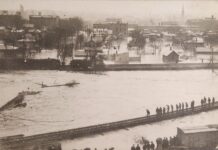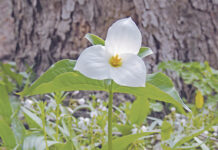America’s black powder rifles hearken back to the era between the 17th-century Pilgrims through the end of the 19th century. Some were sent on ships from Europe to support the country’s British empire or sold as trade goods. Many were peddled by merchants and bartered by fur traders, including the French-made fusils that were popular with indigenous people.
As the new world expanded, tradesmen began creating their own versions. Some were made using imported English, French or German hardware while others were of colonial manufacture – lock, stock and barrel.
Many of the early rifle barrels were of the familiar smooth-bored type similar to today’s shotguns, a favorite of landholders and hunters. It could use a single ball, buckshot or finer shot for small game. This made it a perfect choice for the utilitarian life of gathering of food while serving as a valuable defensive tool.
A difference maker
Many rifles being built by new-world craftsmen had twisting lands and grooves inside the barrels. This “rifling” placed a spin on a linen-patched roundball, giving it a tremendous advantage in accuracy over it’s smooth-bored brethren. Though these long-barreled rifles were not capable of effectively throwing small shot, its effectiveness at distance was deemed quite desirable on the frontier.
As explorers such as Daniel Boone and Simon Kenton wandered westward, these rifles became invaluable and indispensable possessions. They often meant the difference between death and survival as much as did the skill of the hands that held them.
Today, we tend to collectively call these firearms “Kentucky” rifles, though “long rifle” would be more exact. It’s true that many were indeed built in Kentucky, but most of the continentally crafted arms that were initially hauled into the new land west of Pittsburgh called the Northwest Territory were likely built in Pennsylvania.
As settlements were established and businesses began to flourish, individual rifle makers sprang up in the newest states of Tennessee, Kentucky and Ohio. As had been done for millennia, individuals began to explore the unknown — in this case, it was to follow the stories of the western plains.
Accounts of buffalo and antelope in unimaginable herds streaming through grasslands, huge bears, innumerable beavers and the tails of the Rocky Mountains coaxed rough and ambitious men westward and captured eastern folk’s imaginations.
Soon, another gun maker opened in St. Louis, owned by brothers Samuel and Jacob Hawken. Their much sought after “Plains Rifles” became the standard of those western-wandering mountain men. Both the men and their robustly built Hawkens would become legends of the Rockies.
As the American Civil War was ending in 1865, so was the age of front-stuffing rifles and shotguns. Nearly every sportsman in the country abandoned the old guns for the newer — and much more user friendly — cartridge rifles and shotguns using the ammunition we see on the range and in the hunting fields today. Those historic guns and their shooters were passing into the shades of history. Still, there were a few folks that kept granddad’s long rifle barking.
Henry Ford’s reputation as an industrialist, engineer and inventor of affordable motorcars put his name in every newspaper. When he began toting his enjoyment of collecting old and historically significant items, the antique market blossomed. The Henry Ford Museum of American Innovation in Detroit now houses much of his collection.
Ohio impact
In the late 1920s, this interest of the old-fashioned caught the attention of several Ohio men. They’d always had an interest in muzzle loading rifles and in keeping some of the one-time shooting traditions alive.
Suddenly, others were coming to them with questions about their use and value. They became the founders of the National Muzzle Loading Rifle Association in 1933. That group of friends included William Large from Ironton, Ohio.
Large (1907-1985), likely the best remembered of the lot, was one of the original rifle barrel makers for muzzleloaders during this 20th century revival. He helped popularize the resurgence of “chunk guns” and “over the log” shooting matches which took place on local homesteads with turkeys, hams and sides of bacon as prizes. He continued building rifle barrels into the 1980s, and they’re still prized for both their accuracy and history.
Two other Buckeyes of that time made their mark on preserving this unique American history. These were Wes Kindig (1912-1978) and Tom Pike (1914-2001).
As the old became new again, Wes took his love of the front-loaders and began offering parts, pieces and tools to help bring old guns back to life and, more importantly, to assist in the renaissance of new builders — including the growing popularity of historical reenactments and target shooting.
That was in 1940 but you can still visit his Log Cabin Shop in Lodi, Ohio. There you’ll find his kin selling the same supplies and a display of museum quality antique Ohio-built flint and caplock rifles.
Tom Pike, another Ohio historian who helped establish the NMLRA, was also a collector of the old rifles. A fine shooter himself, it was Tom’s wife Ethel who humbled many a shooter at the rifle range, taking home more than her share of ribbons and trophies.
Pike operated Fort Tuscarora Museum which stood just east of Guilford Lake State Park in Columbiana County. It included a well-stocked store catering to black powder buffs. It also happens to be where I purchased my first front loader for deer hunting. Sadly, the museum and his shop are gone but Tom and Ethel’s impact on preserving Ohio’s heritage will always be evident.
While this resurging interest kept building, Ohio’s deer herd was also making a comeback. Extirpated by the early 1900s, whitetail numbers were steadily returning and bow and gun seasons were put in place.
Primitives comeback
This same group of muzzleloading aficionados saw an opportunity to breathe even more life into their interests. Using their influence, they encouraged the Division of Wildlife to consider a primitive weapons season which would favor flintlock and percussion guns. That same influence was simultaneously driving other states to consider similar seasons. The division determined that the idea was biologically sound and just as safe as other forms of hunting.
The first primitive weapons seasons were set in limited areas near what is now Salt Fork State Park and at Wildcat Hollow in Wayne National Forest. Those opportunities have since expanded to include the entire state.
Today, the NMLRA is based in Friendship, Indiana. The area is a combination of both modern and primitive facilities reflecting the diverse nature of the association and the sport of muzzleloading.
True to their founders, the organization continues to promote, support and preserve our nation’s rich historical heritage in the sport of muzzleloading through recreational, educational, historical and cultural venues. Shooting matches are held regularly as well as an annual national shooting competitions.
Don’t let that Hoosier location dissuade you from learning more. NMLRA has charter clubs in every state with Ohio boasting 27, offering a lot of fun closer to home. A visit will expose you to the same smoke and sulfuric scents drifting on the winds – something so familiar to those who stood fast at Lexington and to frontiersman Davy Crocket.
If you enjoy American history, shooting, the unique experience of historic arms, and good friends – you may want to explore a little more about the Charter Member Clubs of the National Muzzle Loading Rifle Association. Feel free to stop in to watch any one of their shoots – but you may want to take along hearing protection and a camera. Expect to be welcomed with a smile and to leave with a sudden urge to re-read Ohio author Allan Eckert’s “Frontiersmen“ and James Fenimore Cooper’s “Last of the Mohicans.” Learn more about NMLRA at www.nmlra.org. To find those charter clubs, visit www.nmlra.org/charterclubs.
If you’re a hunter who’s never taken up an old-fashioned smoke pole to pursue bushytails or whitetails, these guns and their replicas can be a popular addition in the hunting field. Check the hunting regulations – including Ohio’s primitive season – for opportunities for any aspiring Boone or Kenton. Find Ohio’s hunting regulations at www.wildohio.gov.
“I went to the woods because I wished to live deliberately, to front only the essential facts of life, and see if I could not learn what it had to teach, and not, when I came to die, discover that I had not lived.”
— Henry David Thoreau












